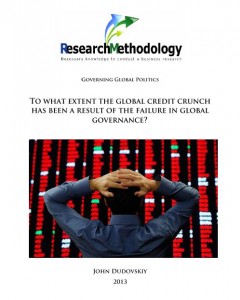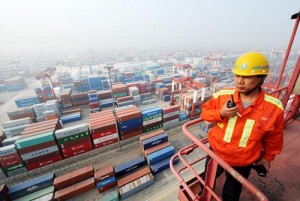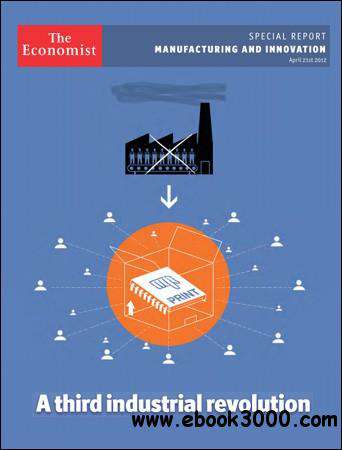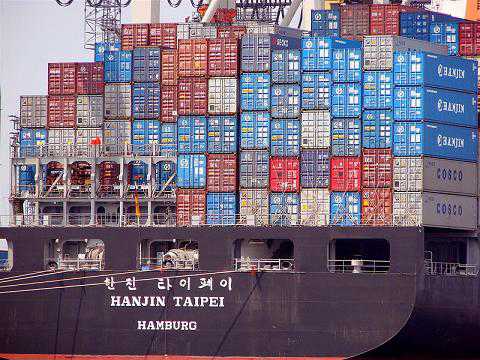Posts Tagged ‘Globalisation’

This paper critically analyses the extent at which a failure in global governance contributed to the recent global credit crunch. The paper starts with discussing the primary reasons of the credit crunch of 2007-2009, and its implications on the global economy. This is followed by analysis of the current state of global governance, and its impact on credit crunch. Moreover, the paper highlights potentials for avoiding credit crunch in the future through improving global governance practices. The global economic and financial crisis of 2007 – 2009 has shed a light in inefficiencies of the international financial system and the current pattern of the global governance. The current system of global financial governance has found to be mainly insufficient to predict and contains financial instability. The need for efficient global governance needs a shift to an improved balance between the two worlds of financial globalization i.e. private financial activity and public financial governance (Porter, 2009). The credit crunch reveals great challenges and threats to the developed economies as well as developing states. The global banking industry, which was by far the most profitable sector in 2006, is in much trouble and the risk that this poses to the real economy is thoughtful (Wade, 2008). The global financial crisis of 2007-triggered by the sub-prime mortgage crisis in the spring previously led to a significant decrease in production in autumn 2008, which has continued in 2009 and went on to produce the spring of 2009 to the present day effects, both social (rising unemployment decrease in disposable income, declining demand, social problems) and political (government changes, erosion of confidence citizens in the performance of governments and the political class), and thus increased the difficulties of public finances in developed countries causing in 2010 a series of crises (Nesvetailova, 2010). 1. Introduction 1 2.…

The routines of adoption have been the conservative and the formats to be prescribed in detail in valuation of assets. The differences under IFRS and GAAP have been seen in the example of Telofonica Company, as its balance sheet showed two different figures in valuation of assets. The financial statement prepared under IFRS showed higher result of assets compared to GAAP mainly because the IFRS lets the companies revalue their assets. Moreover, the strict control of compliance with the Directives (Fourth and Seventh) when using IFRS has also been mentioned as one of the main factors to be taken into consideration. Furthermore, according to one of the respondents, the requirement under the Fourth Directive that annual accounts should present a true and fair view of a company’s assets, liabilities, financial position has also been mentioned as a key factor while adopting IFRS. The findings regarding the adoption of IFRS by EU listed companies are that majority of EU listed companies have adopted the IFRS for more than just for consolidation purposes and their answers have been categorised below according to their level of importance: The process of adoption is complex, burdensome and at the sae time expensive Companies do not think that they can lower the cost of capital even if they apply IFRS Key challenges as mentioned during the interview are lack of guidance while converting and implementing IFRS, lack of uniform interpretation even though IFRS tends to be more flexible and informative And majority of EU companies would not adopt IFRS if it was not required by EU regulation. Moreover, conversion to IFRS will also improve the shareholder orientation in countries such as France and Germany as they used to emphasize on tax regulations and stakeholder orientation, therefore, these country’s investors benefit greatly due to them being as…

“The decision of the Commission of the European Union (EU) to oblige listed European companies…to establish their consolidated financial statements according to IFRS (IAS) represents a preliminary peak in the internationalisation process of financial accounting in Europe” (Haller and Kepler, 2002). The need for Harmonization: The activities of companies extend beyond national frontiers and shareholders and other stakeholders need protection throughout the EU. And in order to achieve this and to encourage the movement of capital, it is necessary to create a flow of reliable homogeneous financial information about companies from all parts of the EU. And they further argue that since companies in different EU countries exist in the same form and are in competition with each other, they should be subject to the same laws and taxation. Obstacles for harmonization in the EU: The obstacles for harmonization are the fundamental differences between the contexts and purposes of the various national accounting systems in the EU. And the main differences are: Differences between creditor/secrecy in the traditional Franco-German systems and investor/disclosure in the Anglo-Dutch systems Differences between law/tax-based rules and private sector standards These difference shave contributed towards the great variations in the size and strength of the accountancy profession. Here are some social-cultural related problems that IFRS can encounter by its implementation in various countries: One of the most crucial issues is the lack of strong professional bodies in some countries to promote the harmonization. The bodies such as IASC (International Accounting Standards Committee). Due to lack of these professional bodies, there will be less guidance to follow and support available. Another point is the degree of professional education and training systems for accounting. Education and training systems in developed and western countries are more professional than in developing countries. Therefore, the accountants in these countries will be sooner…

The “Open Doors Policy” or the economic reformations of the late 1970s in China enormously changed the entire economy of the country. The trade reformation which focused on liberalizing the trade which shifted the country a step closer to free market attracted huge foreign capital into the country in the form of FDI since 1978. The huge scarce resources of China had to be utilized soon after the reformations which indeed required huge capital. However,China heavily relied on the external funds in order to promote its manufacturing industry and the financing of newly privatized formerly state-owned companies. Therefore,China’s government issued series of policies which favoured the foreign investors. The inflows of foreign capital in the form of FDI brought in advanced technology, knowledge, management know-how which accelerated the economic growth in China in the last three decades. Since the “Open Doors” policy and trade reformations in the country in 1978, the country has been consistently achieving significant economic growth which averages at 10% of GDP. When the growth rate of China is compared to other developed economies such as USA which has an average of 3% GDP growth in the 100 years and Germany which has an average growth rate of 1.3% of GDP and Japan at 3.85% of GDP in the few decades, China is far ahead (IMF, 2009). However, many western policy makers and commentators believe that the main source of growth of China has been mainly due to FDI inflows which have been encouraged by fixed exchange rate. The source of economic growth of China is derived from three phases of development which are broken down into three periods of years. The first phase of development lasted from 1952-1978 where the Chinese government prioritized the development of heavy industries such as steel, chemicals and machinery. The second…

This article represents a brief analysis of diversification and expansion opportunities into Chinese market for a local restaurant and cafe in the UK. The article contains a brief overview of Chinese market, discusses market entry strategies available to the business, and discusses a range of most important factors impacting the business proposal. Overview of Chinese Market China is a newly emerging superpower, with the levels of GDP suppressing 72.1 trillion USD in 2011 (Statistical Yearbook, 2012) and the further increase has been forecasted with positive implications on the on the amounts of consumer spending. Currently, a set of multinational fast-food brands such as McDonald’s KFC, and Pizza Hut restaurants are increasing the level of their presence in an aggressive manner that can be interpreted as a signal for increasing level of demand in China towards foreign food and lifestyle. Market Entry Strategies Alternative market entry strategies the restaurant and café can employ in order to enter China consist of licensing, franchising, joint-ventures and wholly owned subsidiaries. Licensing involves local restaurants in China to trade under the license of the UK restaurant. This type of market entry offers the advantages of low risk and lower level of capital requirements. However, the disadvantages include limited scope of participation in operations, and lower potentials for generating significant revenues. Franchising is similar to licensing to a certain extent, but different in a way that it involves closer level of cooperation between the parties, and grants the right to a local business in China to use the logo and trademark of the restaurant in UK. Joint-ventures are another form of market entry available to the restaurant and café in the UK to enter China. The advantages of joint-ventures include shared risk and expenses, and gaining expertise in the local market. However, joint-ventures…

Intensifying forces of economic globalisation have facilitated the shift of production from highly developed countries such as the US and European countries to emerging superpowers like China, India, and Vietnam during the last several decades (Jacques, 2012). However, there is an argument that a set of technological breakthroughs such as introduction of 3D printing may reverse this shift. This article represents a critical analysis of the boomerang effect of competitive advantage in manufacturing in relation to developed countries as discussed in The Economist Special Report entitled Manufacturing and Innovation: A Third Industrial Revolution by Paul Markillie (2012). The article starts with a brief discussion about the rise of China as a world’s largest manufacturer. This is followed by discussing the likelihood of boomerang effect, i.e. shift of production back to rich countries. Moreover, the article contains a discussion of an alternative scenario analysing the chances for China to retain its current manufacturing leadership position in the global scale. Rise of China as a World’s Largest Manufacturer Cheap costs of human resources are widely believed to be one of the main reasons behind the emergence of China as the largest manufacturer in the world. According to the US Bureau of Labour Statistics only several years ago the cost of labour in Chinese factories was as low as 64 cent per hour whereas, hourly pay rate in the US factories amounted to $21.11 (Businessweek Magazine, 2004). Accordingly, this vast difference in employee pay rates has motivated many multinational businesses based in the US and Europe to outsource and offshore their manufacturing to China in an attempt to gain cost advantages. Moreover, highly increasing level of effectiveness of human resources in China can be specified as another factor that has contributed to its status of the largest manufacturer in the world. It has been…

Intensifying forces of globalisation have caused the numbers of expatriates to increase in many counties around the globe. An expatriate is anyone “living or working in a country of which he or she is not a citizen and who can be classified as possessing skills critical to the success of the performance of foreign subsidiaries” (Weber, 2011, p.1). While the skills and competencies brought by expatriates can be highly beneficial for businesses, as well as, for the development of a host country economy; expatriate human resources are influenced by a range of factors. This article analyses the influence of international perspective of employment laws on expatriate human resources. Specific issues discussed in the article include labour law, expatriates, and the impact of legislations issued by international bodies upon expatriate human resources. Labour law and expatriates Specific issues covered by labour law in HR include recruitment and selection, pay and benefits, employment rights, employment contract, provision of training and development, assurance of equal opportunities for all employees, health and safety issues etc. Each of these issues can be analysed from the spectre of expatriate human resources. Recruitment and selection of expatriates differs from recruitment and selection of resident candidates in a way that specific attention needs to be paid to the issues of adaptability to a new culture, candidate’s level of cross-cultural awareness in general, and the level of empathy to the local culture in particular, family situation of candidates, his or her language skills etc (Briscoe et al., 2008). The issues of pay and benefits, as an important aspect of employment covered by employment law represent another point where expatriate human resources are directly influenced. Specifically, a set of related issues such as medical insurance of expatriates and their retirement plans are regulated to the labour law of local…

Objective analysis of the past equips us with necessary knowledge and perspective to deal with the present and future. In other words, the importance of economic history and studying global factors and events that have formed the current economic situation has practical implications in terms of dealing with global economic issues and challenges (Coughlan and Coughlan, 2011). Changes in the world economy taking place since 1945 have resulted in international market expansion for many businesses erasing borders between countries to a certain extent, and providing vast opportunities for businesses. However, this process was not unilinear, i.e. economic changes taking place after 1945 did not have the same impact for all countries and businesses. The nature of economic changes taking place in each geographical location after the Second World War, as well as, the impact of these changes on the performance of private entities depend on a wide range of factors such as political and economic system within the country, the level of economic development and infrastructure etc. Global economic reality by the end of World War II, as aftermath of the Great Depression of 1930’s is referred to as a ‘Golden Age of Capitalism’ and this period lasted until till the beginning of 1970’s (Weber, 2007). Specific factors contributing to the significant rise of consumerism especially in USA in this period include the ‘baby boom’, rapid developments of automobile and aviation industries, and others. The period of the ‘Golden Age of Capitalism’ from 1945 until 1986 is also marked with US dollar becoming the world’s major reserve currency and “between 1945 and the mid-1960s the United States may have accounted for 85 per cent of all new FDI flows” (Jones, 2005, online). Leading positions in many industries were assumed by US corporations in a global scale putting a foundation for…

There is a set of problems developing nations facing in world market when trading with industrialised countries: a) Nondiversified economies Many developing nations’ economies are highly dependent on the advanced nations as majority of their exports go to advanced nations and imports come from these advanced nations (Carbaugh 2004) b) Unstable export markets Another characteristic of many developing nations exports are based on primary products (agricultural products, raw materials and fuels) as shown table below. Therefore, when there is a poor harvest or decrease in demand for nation’s specialised product, it can significantly reduce revenues from export and seriously disrupt domestic income and damage employment levels. (Carbaugh 2004). Developing-Nation Dependence on Primary Product 2000 Country Major Export Product Major Export Product as a Percentage of Total Exports Nigeria Oil 96% Saudi Arabia Oil 86 Venezuela Oil 86 Burundi Coffee 79 Mauritania Iron ore 56 Zambia Copper 56 Ethiopia Coffee 54 Chad Cotton 40 Rwanda Coffee 31 Adapted from R. Carbaugh’s “International Economics” (2004, p. 234) c) Worsening terms of trade According to Mankiw (2004) developing nations complain that their commodity terms of trade has declined long time ago, meaning that prices of their exports relative to their imports have fallen. Observers maintain that the export prices of primary products of developing nations determined in competitive market, whereas the monopoly of manufacturers in the industrial nations results in high prices. Furthermore, worsening terms of trade has been used to justify refusal of many developing nations from to attend in trade-liberalisation negotiations (Carbaugh 2004). d) Limited market access. Integration of developing countries as whole into world market has improved significantly. However, protectionism and trade barriers imposed by many advanced nations has been hindrance to developing nations’s market access (Economist.com). Specially, global protectionism in agriculture has been major problem for…

Advantages of specialisation for Developing Countries Increased Production. Developing countries with specialisation are able to gain efficiencies generated from economies of scale and increased output (Mankiw 2004) Production Efficiency. The more efficient use of resources, the higher will be productivity of output of domestic goods and services. Furthermore, international competition leads to use of new technology and marketing methods (Parkin 2008). Benefit to Customers. Parkin (2008) mentions that specialisation in producing limited range of products offer wide range of choice for customers around the world at lower prices as people have tremendous diversity in tastes for different products and they value variety. Arguments against Free Trade and Specialisation. However, Carbaugh (2004) argues that the key to success in free trade can be achieved only through mutually beneficial approach, which satisfies both the giver and taker. Though law of comparative advantage maintains that nations benefit equally from international trade, there might not be mutual benefits between strong and weak countries, as the strong countries tend to take more advantage of it (Mankiw 2004). Many economists believe that current international markets are not level playing field and trade systems in practice favours developed countries and hinder development in the developing or less-developing nations (Carbaugh 2004). They also suggest that organisations such as IMF or WTO mainly work to fulfil interest of powerful countries (Parkin 2008). Another fallacy about free trade is that imports reduce employment, while exports promote growth. Therefore, the notion that import are “bad” while exports are “good” particularly popular among politicians and media (Carbaugh 2004). References Carbaugh (2004) “International Economics”, Ninth Edition, Thomson, New York Mankiw (2004) “Principle of Macroeconomics”, South Western, USA Parkin (2008) “Macroeconomics”, Pearson, USA
